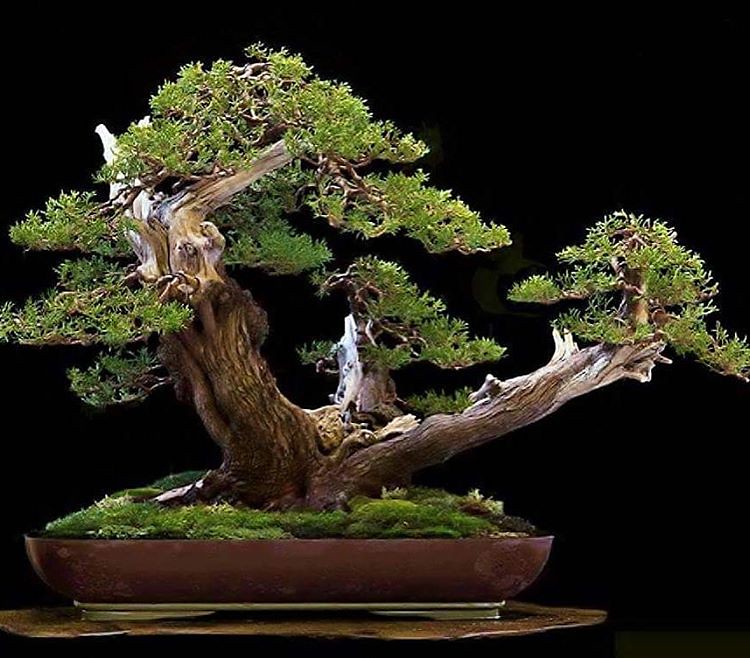The easiest bonsai tree to keep indoors is the Ficus, which is low maintenance and can withstand normal living room conditions. Other indoor species such as the Chinese Elm require a cool room and are best kept outdoors in the summer.
Ficus bonsai trees are considered the best choice for beginners as they grow well indoors and have supple branches that are easy to shape with wire. They thrive in sunny locations and are extremely low maintenance. Tropical bonsai trees like ficus, Schefflera, dwarf jade, and series are also ideal for beginners as they can be cared for similarly to houseplants.
Introduction To Indoor Bonsai Trees
The Ficus is the easiest indoor bonsai tree to keep, as it can tolerate normal living room conditions. Other indoor varieties like the Chinese Elm require cooler temperatures and may do better outdoors in the summer.
Definition And History Of Bonsai:
Bonsai is an ancient Japanese art form that involves cultivating miniature trees in pots or containers. The word “bonsai” translates to “planted in a container” in Japanese. This art form has its roots in China and was later adopted by the Japanese, who refined and popularized it.
Bonsai trees are trained and pruned to mimic the shape and proportion of full-sized trees, creating a harmonious representation of nature in miniature form.
Benefits Of Having Indoor Bonsai Trees:
Having indoor bonsai trees can bring numerous benefits to your home or office space. Here are some of the advantages:
- Aesthetics: Indoor bonsai trees add a touch of beauty and tranquility to any space. They showcase nature’s intricate beauty in a small, enchanting form.
- Stress Relief: Being around nature has been proven to reduce stress levels. Having an indoor bonsai tree provides a sense of calm and relaxation, helping to create a peaceful environment.
- Air Purification: Bonsai trees can help improve indoor air quality by absorbing toxins and releasing oxygen. They act as natural air purifiers, enhancing the overall freshness of the space.
- Horticultural Therapy: Taking care of indoor bonsai trees can be a therapeutic and rewarding experience. It allows you to connect with nature, reducing anxiety and promoting mindfulness.
- Learning and Patience: Growing and maintaining indoor bonsai trees requires patience and attention to detail. It provides an opportunity for continuous learning and personal growth.
- Space Optimization: Bonsai trees are compact and can fit in small areas, making them suitable for any indoor space, including apartments, offices, and even windowsills.
With their unique charm and benefits, indoor bonsai trees offer a captivating way to bring nature indoors. Whether you are a seasoned bonsai enthusiast or a beginner, these miniature trees can be a delightful addition to your indoor space.
Factors To Consider For Indoor Bonsai Trees
When selecting trees for indoor bonsai, consider factors such as the Ficus, which is the easiest to maintain, and the Chinese Elm, which thrives in cooler environments. Choose a variety that can withstand normal living room conditions or can be kept outdoors during the summer.
Light Requirements For Indoor Bonsai Trees:
- Indoor bonsai trees require bright, indirect light to thrive.
- Place them near a window that receives bright, filtered sunlight for at least 4-6 hours a day.
- Avoid placing them in direct sunlight as it can scorch the leaves and damage the tree.
- If you don’t have a well-lit area, you can supplement the light with artificial grow lights specifically designed for bonsai trees.
- Rotate the tree periodically to ensure even exposure to light and prevent it from leaning toward the light source.
Temperature And Humidity Considerations:
- Most indoor bonsai trees prefer temperatures between 60-75°F (15-24°C). Avoid exposing them to extreme temperature fluctuations.
- Keep your bonsai tree away from drafts, such as near air conditioning vents or open windows.
- Indoor bonsai trees also require moderate humidity levels, which can be a challenge in dry indoor environments.
- To increase humidity, you can place a humidity tray filled with water near the tree or use a room humidifier.
- Avoid placing the bonsai tree near heaters or radiators, as it can cause the soil to dry out quickly.
Watering And Fertilizing Tips:
- Watering is crucial for the health of indoor bonsai trees. Check the moisture level by inserting your finger into the soil up to the second knuckle. If it feels dry, it’s time to water.
- Water your bonsai tree thoroughly, allowing water to drain out from the bottom of the pot. Avoid overwatering, as it can lead to root rot.
- The frequency of watering depends on factors such as tree species, pot size, and environmental conditions. It’s best to observe the tree and adjust watering accordingly.
- Use a well-draining bonsai soil mix that retains moisture without becoming waterlogged.
- Fertilize your indoor bonsai tree with a balanced liquid or granular fertilizer specifically formulated for bonsai trees. Follow the instructions on the fertilizer packaging for proper dilution and frequency.
- During the growing season (spring to summer), fertilize your tree every 4-6 weeks. Reduce or stop fertilizing during the dormant season (fall to winter).
Remember to consider these factors when choosing and caring for your indoor bonsai trees to ensure their health and longevity.
Best Tree Options For Indoor Bonsai
The Ficus tree is considered the best option for indoor bonsai, as it is low maintenance and can thrive in normal living room conditions. Other options such as the Chinese Elm may require a cooler room or outdoor placement during summer.
Ficus Bonsai: The Easy-To-Maintain Choice
The Ficus bonsai is widely regarded as the easiest tree to keep indoors. It requires minimal care and can thrive in normal living room conditions. Here are some reasons why the Ficus bonsai is a popular choice:
- Low maintenance: Ficus bonsai trees are known for their low maintenance requirements. They can withstand a variety of conditions, making them perfect for beginners.
- Indoor suitability: Ficus bonsai trees are well-suited for indoor environments. They can tolerate moderate light conditions, making them adaptable to various spaces in your home.
- Year-round foliage: One of the unique attributes of Ficus bonsai trees is their ability to maintain their vibrant foliage throughout the year. This makes them visually appealing and adds beauty to any indoor space.
- Easy bending: The supple branches of Ficus bonsai trees allow for effortless shaping and bending. This makes them ideal for bonsai enthusiasts who enjoy the art of tree manipulation.
- Versatile styling: Ficus bonsai trees boast a wide range of styling options, including various shapes and sizes. This versatility allows you to personalize your tree according to your preferences and aesthetic vision.
Overall, Ficus bonsai trees are the top choice for beginners and those seeking an easy-to-maintain indoor bonsai tree. Their hardiness, adaptability, and aesthetic appeal make them a fantastic addition to any home or office space.
Chinese Elm Bonsai: Suitable For Cool Rooms
The Chinese Elm bonsai tree is another excellent option for indoor cultivation, particularly in cool room environments. Here are some key traits that make Chinese Elm bonsai trees a suitable choice:
- Cool room tolerance: Unlike the Ficus bonsai tree, which thrives in normal living room conditions, the Chinese Elm prefers cool room temperatures. This makes it an ideal choice for those who can provide a cooler climate for their bonsai.
- Outdoor suitability: Chinese Elm bonsai trees excel outdoors during the summer months. If you have the option of placing your bonsai outside, the Chinese Elm will greatly benefit from the increased sunlight and fresh air.
- Distinctive bark: The Chinese Elm bonsai tree features an attractive mottled bark, adding visual interest and texture to your indoor bonsai collection. This unique characteristic sets it apart from other indoor bonsai options.
- Disease resistance: Chinese Elm bonsai trees exhibit remarkable resistance to common bonsai diseases such as powdery mildew and root rot. This resilient nature makes them an easier choice to maintain and keep healthy.
- Ability to tolerate pruning: Pruning is an essential aspect of bonsai care, and the Chinese Elm bonsai tree responds well to regular pruning. This allows for shaping and styling according to your desired aesthetic.
The Chinese Elm bonsai tree is a great option for those looking for a bonsai that prefers cooler room temperatures. Its outdoor versatility, distinctive bark, resistance to disease, and ability to tolerate pruning make it a popular choice for bonsai enthusiasts.
Tips For Caring For Indoor Bonsai Trees
The Ficus bonsai is the easiest tree for indoor bonsai beginners, as it thrives in normal living room conditions and requires minimal maintenance. Other indoor bonsai varieties, such as the Chinese Elm, may need a cooler room or can be kept outdoors during the summer.
Picking The Right Pot And Soil For Your Bonsai:
- Choose a pot that suits the size and style of your bonsai tree:
- A shallow pot is ideal for trees with a spreading root system.
- A deeper pot is suitable for trees with a deep taproot.
- Select a pot with good drainage holes to prevent waterlogging.
- Use the right soil mix for your bonsai:
- Bonsai soil should be well-draining to prevent root rot.
- A mix of Akadama, pumice, and lava rock is commonly used.
- Avoid garden soil, as it tends to retain too much moisture.
Pruning And Wiring Techniques For Shaping The Tree:
- Prune your bonsai regularly to maintain its shape:
- Remove unnecessary branches and shoots to enhance its aesthetic appeal.
- Prune during the tree’s dormant period to minimize stress.
- Use wiring techniques to shape your bonsai:
- Wrap aluminum or copper wire around branches to achieve the desired shape.
- Be gentle to avoid damaging or cutting into the bark.
Preventing Pests And Diseases In Indoor Bonsai Trees:
- Keep your bonsai tree healthy to prevent pests and diseases:
- Regularly inspect your tree for signs of pests such as aphids or spider mites.
- Treat infestations promptly to prevent them from spreading.
- Provide proper ventilation and airflow:
- Ensure your bonsai is not placed in a stagnant air condition.
- Good airflow helps prevent the development of fungal diseases.
- Avoid overwatering your bonsai:
- Water your bonsai only when the topsoil feels slightly dry.
- Overwatering can lead to root rot and attract pests.
Remember, caring for indoor bonsai trees requires attention and patience. By following these tips, you can ensure your bonsai thrives and remains a beautiful addition to your indoor space.
Displaying And Showcasing Indoor Bonsai Trees
Displaying and showcasing indoor bonsai trees can be a beautiful way to bring nature indoors. The best trees for indoor bonsai include the Ficus, Chinese Elm, and Jade Tree, all of which are low maintenance and thrive in normal living room conditions.
Choosing The Right Bonsai Display Stand:
- A bonsai display stand is an essential element for showcasing your indoor bonsai tree. Here are some key points to consider when selecting the right stand:
- Material: Choose a stand made from durable and high-quality materials such as wood or ceramic. This will ensure stability and enhance the aesthetic appeal of your bonsai tree.
- Size and proportion: The size and proportion of the display stand should complement the size of your bonsai tree. It should neither overpower nor be too small for the tree.
- Design: Opt for a display stand with a design that complements the style of your bonsai tree. Whether traditional or contemporary, the stand should enhance the overall visual impact.
- Balance: Look for a display stand that provides a stable base and maintains a balanced position for your bonsai tree. This will create a harmonious and visually pleasing display.
- Functionality: Consider the practicality of the display stand. It should provide adequate support for your bonsai tree and allow for easy watering and maintenance.
Incorporating Bonsai Into Your Home Decor:
- Integrating your indoor bonsai tree into your home decor can bring a sense of tranquility and natural beauty. Here are some ideas on how to incorporate bonsai into your home:
- Placement: Choose a prominent spot in your home, such as a display shelf or a dedicated bonsai table, to showcase your bonsai tree. This will ensure that it becomes a focal point and adds character to the space.
- Lighting: Provide adequate natural or artificial light for your bonsai tree, as it is essential for its growth and overall health. Place it near a window with filtered sunlight or use grow lights to simulate natural conditions.
- Style and theme: Consider the overall style and theme of your home decor when selecting a bonsai tree. Whether you prefer a minimalist or a more elaborate setting, choose a bonsai tree that complements the aesthetic.
- Decorative elements: Enhance the visual appeal of your bonsai display by adding decorative elements such as decorative rocks, miniature figurines, or a small water feature. These elements can add personality and depth to the overall design.
Participating In Bonsai Exhibitions And Competitions:
- Bonsai exhibitions and competitions provide unique opportunities to showcase your indoor bonsai tree and learn from other enthusiasts. Here’s why you should consider participating:
- Networking: Bonsai exhibitions and competitions bring together bonsai enthusiasts from all over the world. By participating, you can connect with fellow enthusiasts, exchange ideas, and expand your network.
- Feedback and learning: Exhibitions and competitions offer valuable feedback from bonsai experts and judges. This feedback can help you improve your bonsai techniques and refine your skills.
- Inspiration: Seeing a wide variety of bonsai trees displayed at exhibitions can be a great source of inspiration. It exposes you to different styles, techniques, and artistic interpretations, allowing you to broaden your horizons as a bonsai artist.
- Recognition and validation: Winning awards or receiving recognition at bonsai exhibitions and competitions can boost your confidence and validate your skills as a bonsai artist. It can also open doors to further opportunities and collaborations.
Remember, displaying and showcasing your indoor bonsai tree is not just about aesthetics; it’s also a way to share your passion for this ancient art form with others. Whether through a well-chosen display stand, integration into your home decor, or participating in exhibitions and competitions, you can bring the beauty of bonsai into your life and enrich your bonsai journey.
Frequently Asked Questions On Best Trees For Indoor Bonsai
What Is The Easiest Bonsai Tree To Keep Indoors?
The easiest bonsai tree to keep indoors is the Ficus. It is low-maintenance and can tolerate normal living room conditions.
What Is The Easiest Bonsai Tree For Beginners?
The easiest bonsai tree for beginners is the Ficus. It is low maintenance and can grow well indoors.
What Is The Easiest Bonsai Tree To Keep Alive?
The easiest bonsai tree to keep alive indoors is the Ficus. It is low maintenance and can tolerate normal living room conditions.
What Is The Best Bonsai Tree For Indoors Indirect Light?
The best bonsai tree for indirect indoor light is the Ficus Retusa (Ficus Tree), Chinese Elm (Ulmus parvifolia), Jade Tree (Crassula ovata), Hawaiian Umbrella (Schefflera arboricola), Dwarf Pomegranate (Punica Granatum), Japanese Maple (Acer Palmatum), and Ponytail Palm (Beaucarnea recurvata).
Can I Plant Bonsai Trees and Succulents Together Indoors?
Yes, you can definitely plant bonsai trees and succulents together indoors. Bonsai trees add an element of tranquility while succulents provide a pop of color. To ensure successful cohabitation, follow these foolproof succulent planting tips to create a harmonious indoor garden.
Conclusion
In this blog post, we explored the best trees for indoor bonsai. Among the various options, the Ficus bonsai tree stands out as the easiest to keep indoors. Its ability to thrive in normal living room conditions makes it the most trouble-free option for beginners.
On the other hand, the Chinese Elm bonsai tree prefers a cooler environment and can be kept outdoors during the summer. For those looking for a low-maintenance and beginner-friendly indoor bonsai tree, the Ficus is highly recommended. Its supple branches make it easy to shape with wire, and it can grow well in a sunny location.
Other options for indoor bonsai trees include the Jade Tree, Hawaiian Umbrella, and Japanese Maple. Remember to consider the ideal location for each tree, as some thrive indoors while others may need to be moved outdoors in certain seasons. Choose the tree that suits your preferences and living conditions, and enjoy the beauty and tranquility that indoor bonsai trees bring to your space.
Related Articles:
Insect Invasion: Threat to Utah’s Fir Forests
 Dr Ahsanur Rahman, PHD
Dr Ahsanur Rahman, PHD
UK Forests Collapse Imminent: Act Now Against Climate!
 Dr Ahsanur Rahman, PHD
Dr Ahsanur Rahman, PHD
Lightning Strikes Threat: Boreal Fires Jeopardize Carbon
 Dr Ahsanur Rahman, PHD
Dr Ahsanur Rahman, PHD









